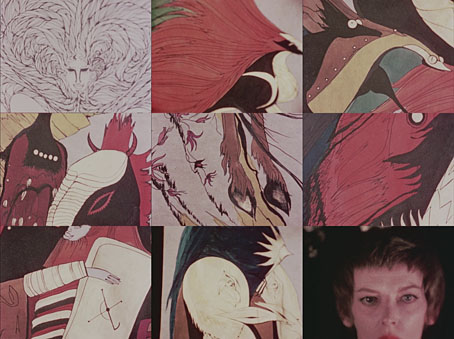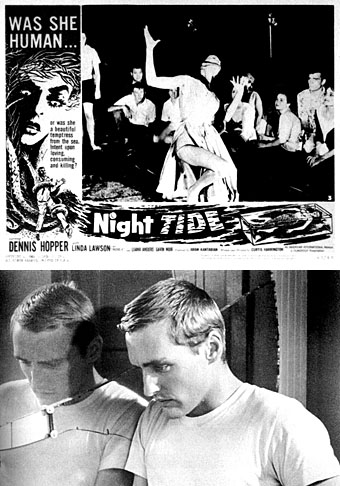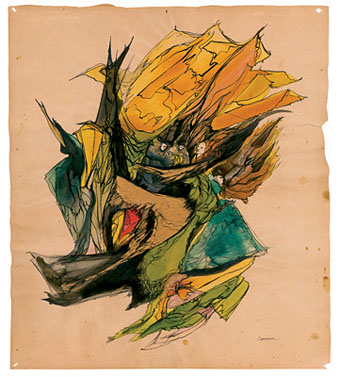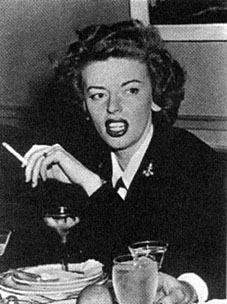
Filmska studija okultističkih slika Harringtonove prijateljice Marjorie Cameron (1922–1995), poznate po ulozi Scarlet Woman u Angerovu filmu Inauguration of the Pleasure Dome.
I’ve waited about 20 years to see this one, after first learning of it via a Curtis Harrington interview in Michael Weldon’s Psychotronic magazine in the 1990s. The Wormwood Star (1956) is a 10-minute study of the occult art and witchy persona of Harrington’s friend Marjorie Cameron (1922–1995), best known these days for her memorable incarnation as the Scarlet Woman in Kenneth Anger’s Inauguration of the Pleasure Dome (1954), a film in which Harrington also appeared. With her flame-red hair, green eyes and basilisk gaze, Cameron (as she preferred to be called) would have made an impression wherever she landed. Her presence in Anger’s film is so striking that stills of her face have often been used to stand for the entire Magick Lantern Cycle.
In The Wormwood Star Harrington ramps up the mystique with oblique shots and at least half the running time given to Cameron’s strange drawings and paintings. The subtitle, “Concerning the Knowledge and Conversation of the Holy Guardian Angel” harks back to the 1940s and her husband, Jack Parsons, a rocket researcher and, for a time, the American head of Aleister Crowley’s Ordo Templi Orientis. Harrington later gave Cameron a wordless role as the “Water Witch” in his low-budget horror film, Night Tide (1961), where she drifts around Venice Beach looking suitably mysterious. Night Tide is out-of-copyright so can be watched in full at YouTube. The Wormwood Star appeared on a Curtis Harrington DVD only last month which is no doubt where this copy originates. It may not stick around so watch it while you can. - www.johncoulthart.com/

House of Harrington is a short documentary from 2008 about the late filmmaker Curtis Harrington which has just been posted to YouTube by its makers, and by a curious coincidence this appearance occurs in the week of Dennis Hopper’s death. Harrington gave Hopper the lead in his debut feature Night Tide (1961) at a time when the actor was ostracised in Hollywood after a falling out with director Henry Hathaway. Hopper’s diligent performance in Harrington’s film, a low budget horror, is a long way from the histrionics one usually finds in works of this sort and is a good reason to seek it out.

Marjorie Cameron in The Wormwood Star.
Also in Night Tide in a wordless role is the enigmatic occult artist Marjorie Cameron who drifts around looking spooky and mysterious. Cameron had earlier appeared with Harrington in Kenneth Anger’s Inauguration of the Pleasure Dome (1954), he as Cesaré the Somnambulist from Caligari, she as Aleister Crowley’s Scarlet Woman. That encounter led to Harrington making her the subject of one of his experimental shorts, The Wormwood Star in 1956. I’ve wanted to see this film for years, if only to sate a persistent curiosity, and House of Harrington contains a few tantalising glimpses. With luck it may turn up on YouTube (or even DVD) in the future.
Lastly, Automat Pictures, the makers of House of Harrington, also have a lengthy filmed lecture in their channel, Queer for Fear, which “explores gay and lesbian subtext in the horror film, and examines the intertwining of queer history and monster movies.” - www.johncoulthart.com/
House of Harrington: Part 1 | Part 2 | Part 3 | Part 4

Curtis Harrington, who died on Monday, was chiefly known as a director of low-budget horror films, the most acclaimed of which is his debut feature Night Tide (1961), a watery riff on Cat People (1942) starring a young Dennis Hopper. But Harrington should also be remembered for his associations with early American avant garde cinema, especially the productions of Kenneth Anger. Harrington was behind the camera for Anger’s Puce Moment (1949) and appeared in front of it as Cesare the Somnambulist in Inauguration of the Pleasure Dome (1954). Harrington’s early films were similarly uncommercial experimental shorts, one of which, The Wormwood Star (1956), was based around the paintings and person of Marjorie Cameron Parsons Kimmel aka Cameron. Harrington and Cameron both appeared in Anger’s Pleasure Dome and Harrington featured Cameron again when he came to make Night Tide, where she appears as a mysterious, witch-like presence.
Night Tide is well worth a look, despite the limitations of its budget. Dennis Hopper had been ostracised from Hollywood after a fall-out with director Henry Hathaway and was hanging around with various artists and experimental filmmakers (including Andy Warhol’s crowd), acting in TV shows and generally biding his time. Harrington gave him a starring role and the opportunity to pull some Method faces, and he’s very impressive as he falls for a girl who may or may not turn into a murderous sea creature with the next full moon. Good use is made of the crumbling beachfront of Venice, CA, and there’s some sly camp humour to be found in Hopper’s appearance (he’s dressed in a sailor uniform most of the time, looking like an extra from Anger’s Fireworks), and in the scene where he goes for a (chaste) massage. Night Tide isn’t as strange as Carnival of Souls (1962) but both films share enough of the same atmosphere and period detail to make a perfect double-bill.
- www.johncoulthart.com/
American filmmaker Curtis Harrington died five years ago today. His memorial service was evidently quite the to-do, the eulogy read by an actor from a 1950s series of Superman with interjections by Kenneth Anger – a neat illustration of Harrington’s intersecting worlds.
Harrington was more or less the same age as Anger, and both filmmakers grew up in Los Angeles obsessed with movies and apparently emboldened by their proximity to Hollywood to take the means of production into their own hands. Harrington’s idiosyncratic career began in 1942 (around the time of Anger’s own first experiments) with a home-made adaptation of Poe’s Fall of the House of Usher. As a child, Harrington had been mesmerised by Edgar Allan Poe’s short stories. Throughout the director’s own career there are echoes not only of Poe’s arch morbidity but also his blend of pen-for-hire pragmatism and creative innovation.
Few, after all, have bridged the avant-garde and the commercial as deftly as Harrington. He impressed Maya Deren with his experimental films while adapting a schlocky Russian sci-fi movie for American consumption, wrote for Cahiers du Cinéma and directed episodes of Charlie’s Angels, was equally comfortable analysing the arthouse and the grindhouse.
In 1954 Harrington appeared as an actor in Anger’s Inauguration of the Pleasure Dome which also featured Marjorie Cameron, whose artwork was the focus of Harrington’s little-seen short Wormwood Star the following year. Cameron was once again on hand when Harrington finally made his first feature, the independently-produced Night Tide (1961) which also gave Dennis Hopper one of his first starring film roles, as a sailor in love with a mermaid.
Harrington’s subsequent work often ended up in late-night limbo, but even his most mainstream films were invested with an eerie otherness, and it was with evident pride that he noted that “they all have a tragic ending, every one of them.” Another constant was his gift for creating strong female roles and casting strong females to perform them, including Simone Signoret, Shelley Winters and Gloria Swanson. He even coaxed a serviceable performance out of Sylvia Kristel.
Harrington’s obsessions were nothing if not durable and in 2002 he ended his career with another version of The Fall of the House of Usher, 60 years after his first.
All of this can be seen in the 25-minute documentary below, and there’s a great interview with Harrington here.
- strangeflowers.wordpress.com/



Nema komentara:
Objavi komentar